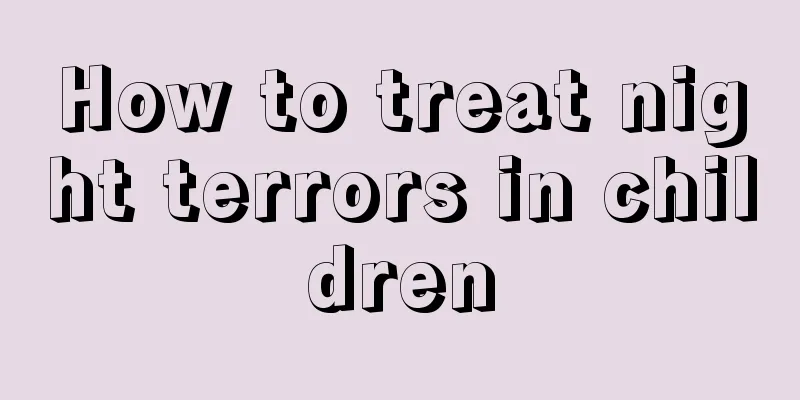How to treat night terrors in children

|
Some places in our country are very superstitious. Some people say that children's night terrors are caused by their souls being captured by ghosts and gods. In fact, this is not the case. Children's night terrors are a disease. Some people may not understand what kind of disease children's night terrors are. So let's sit down and learn about the symptoms of children's night terrors, how to treat them, and what kind of medicines should be taken to quickly cure children's night terrors. Night terrors refer to a sleep disorder common in children, characterized by repeated sudden awakening from sleep and screaming, usually occurring in the first third of sleep, about 15-30 minutes after falling asleep; occurring during NREM sleep. Children suddenly scream or cry in their sleep with frightened expressions and movements, their eyes staring, their hands and feet moving around, and they have symptoms of autonomic nervous excitement such as increased heart rate, rapid breathing, sweating, and dilated pupils. They usually occur within a short period of time after sleep at night, and each attack lasts about 1-10 minutes. It was difficult to wake him up, as his consciousness was hazy at the time. After waking up, the patient has impaired consciousness and orientation, cannot describe the content of the dream, and cannot recall the attack. Night terrors refer to sudden awakening during sleep, with eyes staring straight ahead, expression of tension and fear, rapid breathing, increased heart rate, accompanied by loud shouting and restlessness. The attack lasts for 1 to 2 minutes, after which the person falls asleep again, and cannot recall the attack after waking up in the morning. Night terrors are also called sleep terrors. The patient suddenly sits up during sleep and screams, accompanied by autonomic nervous system signs such as rapid heartbeat, breathing, and profuse sweating. There are intense feelings of fear, anxiety and suffocation, and occasional hallucinations, such as seeing ghosts. Each attack lasts about 1-2 minutes, and the patient usually has no memory of it after waking up in the morning. This is different from nightmares. It is more common in children, and most of them recover on their own when they grow up. Adults with the condition often have anxiety disorders or may have undiagnosed visceral diseases. Treatment is with diazepam. Diagnostic examination of night terrors: The patient wakes up from sleep with a scream repeatedly, accompanied by intense anxiety, body movements and autonomic hyperactivity (such as tachycardia, rapid breathing and sweating). Lack of response to attempts by others to calm the night terror, followed by at least several minutes of disorientation and persistent movements. We forget things afterwards, and even if we can recall them, it will be very limited. Secondary night terrors caused by organic diseases (such as dementia, brain tumors, epilepsy, etc.) should be excluded, as well as febrile convulsions and epileptic seizures. Treatment plan for night terrors in children: Arrange children's lives in a regular manner to avoid excessive fatigue and overexcitement during the day. Don't tell exciting stories or watch thrilling or scary movies before bed, and don't use threatening methods to coax children to sleep. Let children fully relax before going to bed and fall asleep peacefully in a relaxed and happy mood. If necessary, you can also use less benzodiazepines. Therefore, it is not terrible for children to suffer from night terrors. What is terrible is that parents do not treat it correctly and use some feudal methods to treat their children, which delays the children's illness. So, after we understand this, we all have a very good understanding of what night terrors are like. Only by taking regular hospital treatment methods can the child's condition heal quickly. Here's wishing your child a speedy recovery. |
<<: What to eat when children have a fever
>>: What are the dangers of snoring and breath holding in children?
Recommend
My nine-month-old baby can't crawl
Everyone should be familiar with this. For exampl...
What medicine should children take for severe indigestion?
When babies don’t like to eat, parents will force...
What should I do if my child refuses to do his homework?
Children's lives are rich and colorful, but th...
How to treat asthma in children and what should you pay attention to?
Asthma is related to polygenic inheritance. The p...
What can children eat to reduce internal heat?
Whether adults or children, they are prone to the...
Massage techniques for reducing fever in children
In the field of Western medicine, it is generally...
The baby suddenly has red bumps all over his body
If your baby suddenly develops red bumps all over...
What to do if your baby has trouble digesting breast milk
There are many benefits of breastfeeding. The ben...
The harm of enema for nine-month-old babies
Try not to use enema treatment on 9-month-old bab...
What should I do if my child has a sore throat?
Many children, when they are young, have relative...
10 things parents must teach their children before they turn 10
Educating children is a long and arduous task, an...
How old is the baby when all the teeth grow
Many parents hope that their baby's teeth can...
Redness inside the nostrils of a newborn
The inside of the nostrils of a newborn baby beco...
Mild brain injury in newborns
Brain damage in newborns can cause great harm, an...
Is it okay for a boy to have two whorls on his head?
It is usually neither good nor bad for a boy to h...









